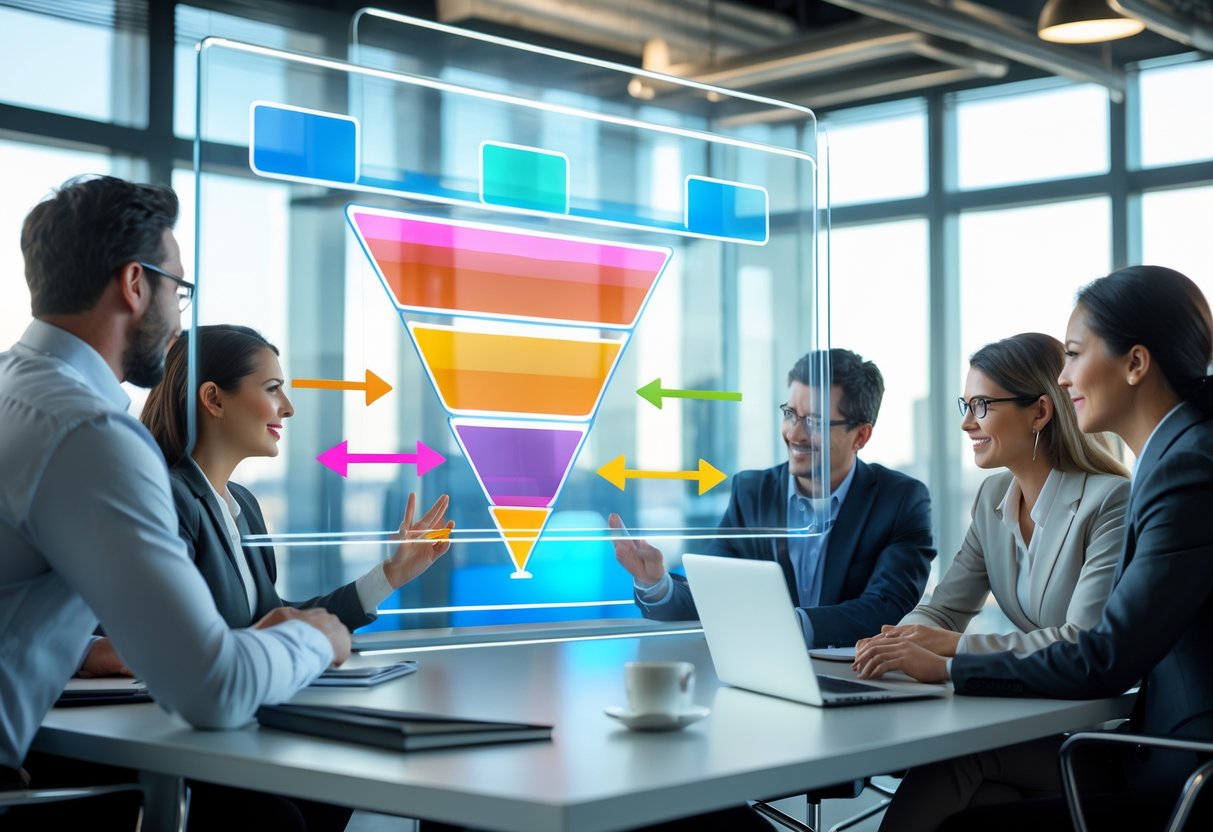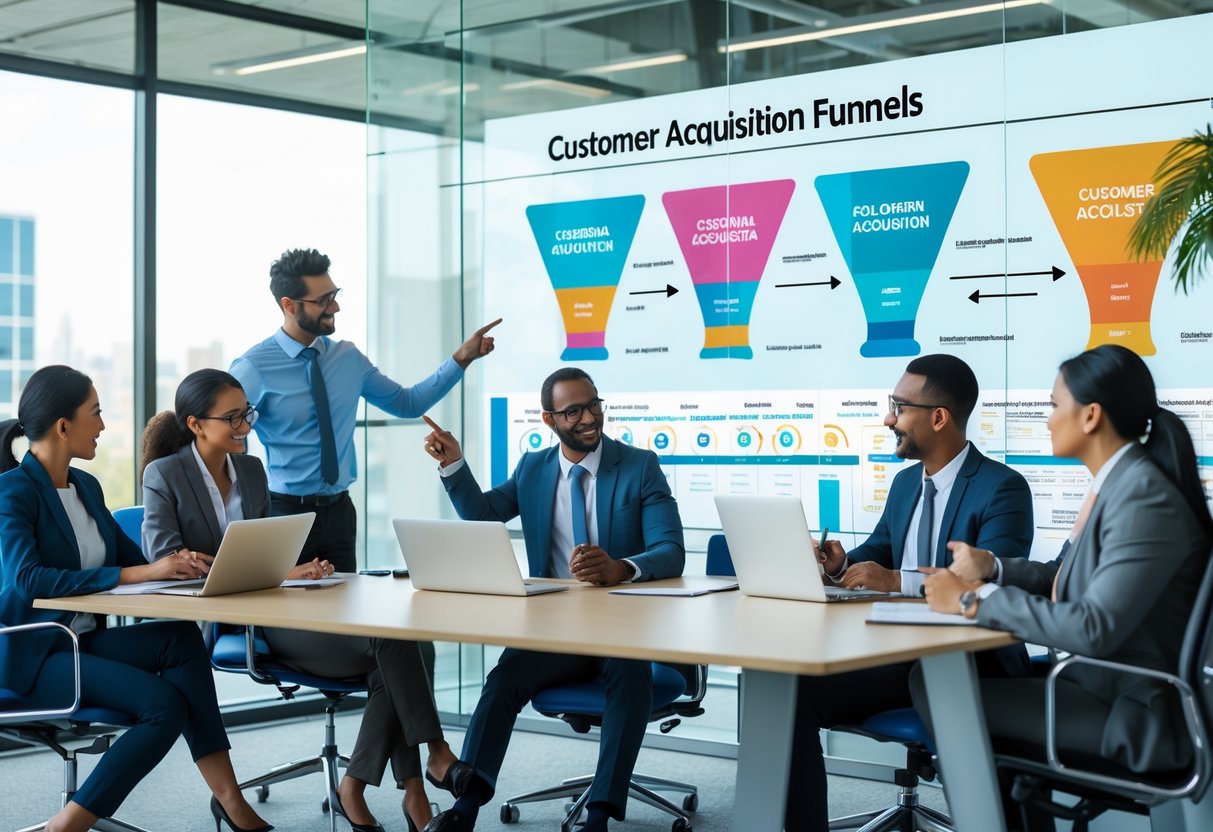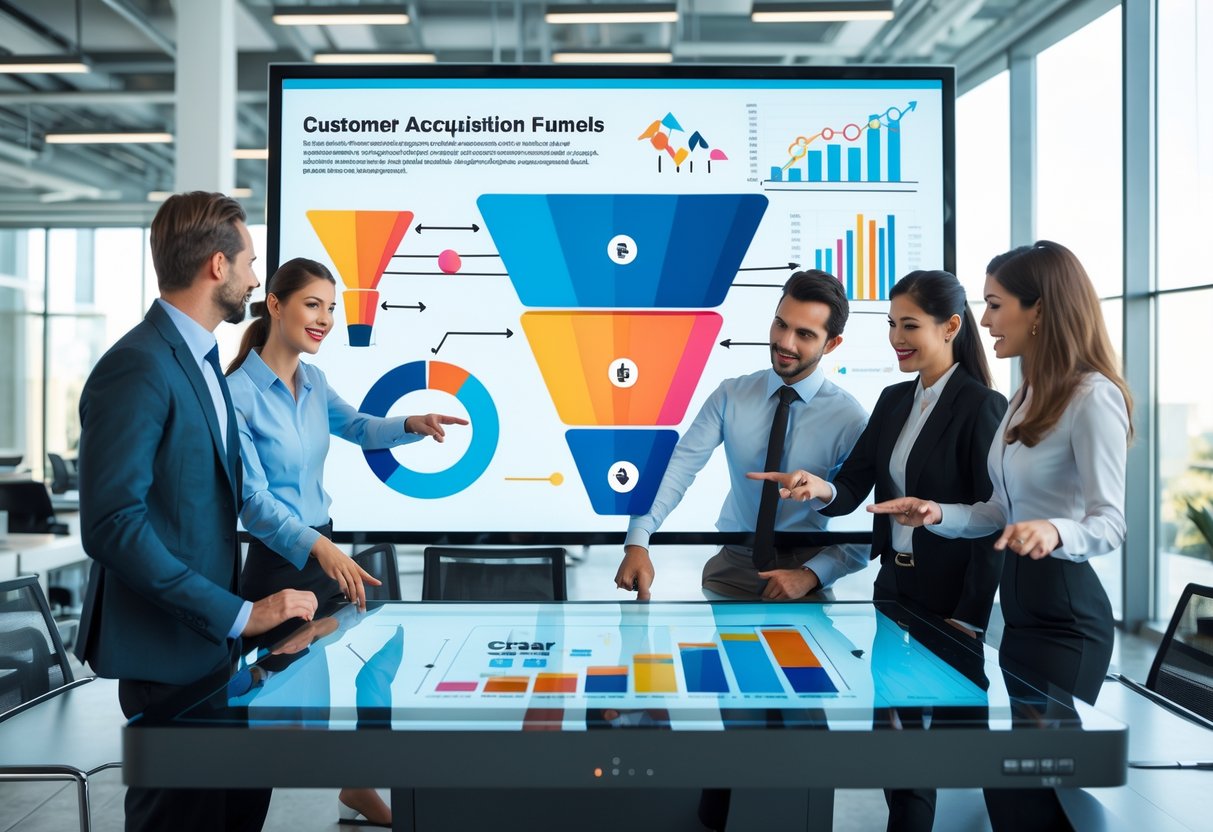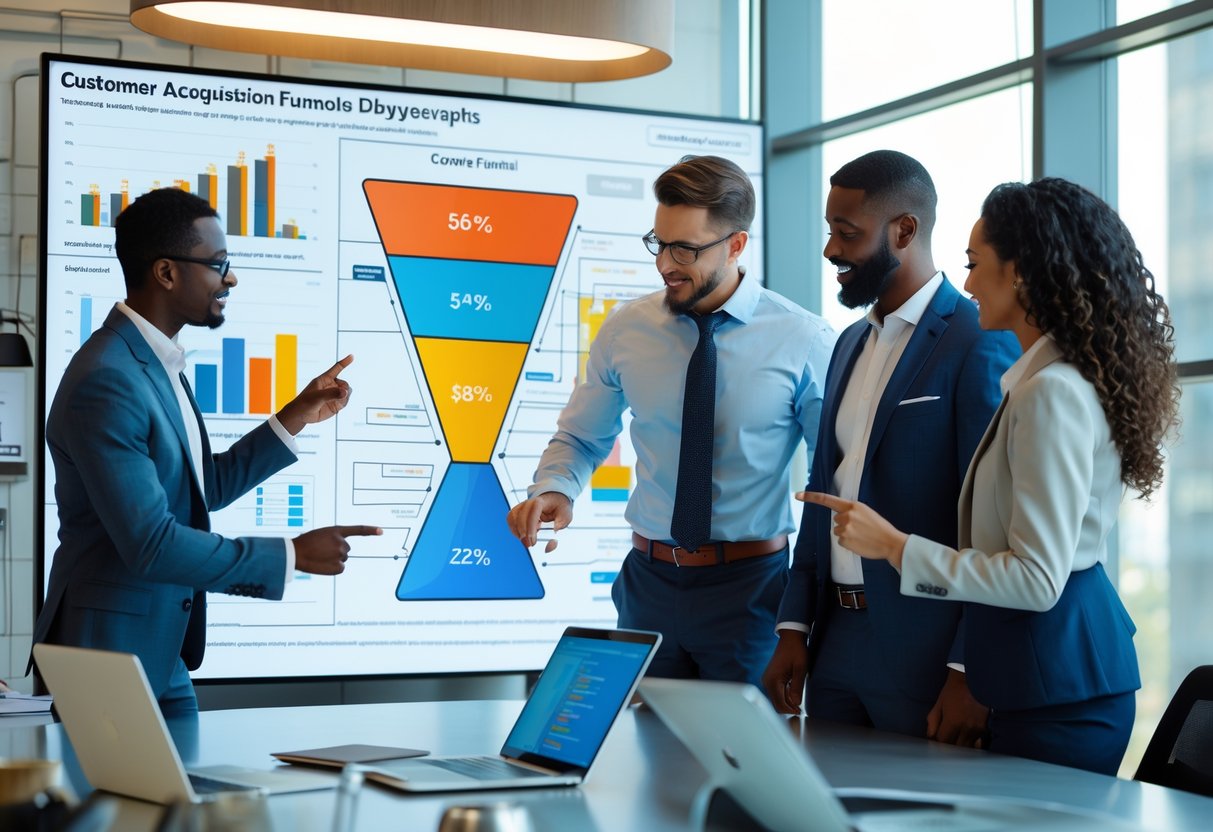A customer acquisition funnel lays out the path someone takes from the moment they notice a brand to when they finally become a paying customer.
It’s a step-by-step model—think of it as a roadmap for attracting, engaging, and converting people into loyal buyers.
If you understand how this process works, you’ll spot gaps, tweak your approach, and increase conversions without running yourself ragged.

I lean on this framework because it shows me exactly what’s working at each stage.
No more wild guessing—I can zero in on the actions that move people forward, whether that’s building awareness, sparking interest, or making the purchase process ridiculously easy.
When you get the funnel, you actually control how potential customers interact with your brand.
That means you can design strategies that don’t just bring in new customers, but keep them coming back for more.
Key Takeaways
- A funnel maps the path from awareness to loyal customer.
- Each stage needs its own strategies to boost conversions.
- Regular tracking and tweaks lead to better results over time.
Understanding Customer Acquisition Funnels
I use a customer acquisition funnel to see how people move from just hearing about a product to actually handing over their money.
It lets me measure every step of the journey and make changes that genuinely improve the customer experience and conversion rates.
Definition and Purpose
A customer acquisition funnel is basically a structured path showing how prospects move through stages before becoming customers.
It starts broad with awareness and narrows down to decision and purchase.
The purpose is straightforward: track behavior, spot where people drop off, and improve how I guide them through the buying process.
By mapping these stages, I can see where prospects lose interest and where they’re actually engaging.
Each stage needs a different approach.
For example, awareness might need ads or SEO, while consideration could mean offering free trials or demos.
This model gives me a clear framework to test new ideas and see what sticks.
Customer Acquisition Funnel vs. Marketing Funnel
People mix these up all the time, but they’re not identical.
A marketing funnel focuses on attracting and nurturing leads with campaigns and messaging—it’s about generating interest.
The customer acquisition funnel covers the full journey, from awareness to becoming a paying customer.
It includes both marketing and sales activities, so it’s broader and really ties everything together.
For example, the marketing funnel might stop at lead generation, but the acquisition funnel keeps going until the sale is closed and the customer’s onboarded.
This guide to customer acquisition funnels explains how this structure helps marketing and sales teams actually work toward the same goal.
Key Benefits of Structured Funnels
A structured customer acquisition funnel gives me a few big advantages.
First, I can see where things bottleneck—if lots of leads drop after a demo, I know where to focus.
Second, I can put my resources where they matter most.
I’ll see which channels bring in quality leads and which ones just drain the budget.
Third, it helps with forecasting.
If I track conversion rates at every stage, I can predict revenue better.
And honestly, thinking from the buyer’s perspective (not just the company’s) keeps me focused on what matters.
Core Stages of the Customer Acquisition Funnel
I see the customer acquisition funnel as a structured path guiding prospects from first contact to long-term loyalty.
Each stage calls for different strategies, tools, and touchpoints to move people closer to becoming paying customers—and maybe even brand advocates.
Awareness Stage
At the top of the funnel (TOFU), my main goal is to make sure potential customers know my brand even exists.
This usually means reaching a wide audience who might not even know they have a problem yet.
I use search engine optimization, paid ads, and social media campaigns to build that visibility.
Content like blogs, guides, and videos works well here—it introduces my brand without screaming “buy now.”
The awareness stage always has the most people, but most will drop off.
I track impressions, site visits, and engagement to see if I’m actually catching anyone’s attention.
Here, it’s not about selling; it’s about planting a seed so people remember me later.
Customer acquisition funnel guides back this up—awareness is always step one.
Interest and Consideration Stage
Once people know my brand, they move into the middle of the funnel (MOFU)—this is where they get curious and start evaluating.
They want to learn more and see if my solution fits what they need.
I give them resources like case studies, whitepapers, and webinars to help them out.
Free trials or demos work wonders here because people can test things out before they commit.
This stage is about building trust and showing real value.
I use social proof—reviews, testimonials—to boost credibility.
Personalized email campaigns help address specific concerns and keep leads warm.
During the consideration stage, I watch metrics like trial signups, content downloads, and webinar attendance.
These actions show intent and help me spot leads who are ready to move forward.
Conversion Stage
The bottom of the funnel (BOFU) is decision time.
Here, I’m all about making the purchase process as easy as possible.
I use clear pricing pages, limited-time offers, and simple checkout flows.
Sales teams often jump in with tailored consultations or contract negotiations.
I highlight what sets me apart—unique features, better support, or just more value for the money.
I track conversion rates, cost per acquisition, and average deal size to see how well I’m turning leads into paying customers.
A smooth conversion stage means all that earlier effort actually pays off.
Retention and Advocacy Stage
After the sale, I don’t just disappear.
Customer retention is everything if you want to grow long-term.
Happy customers stick around and usually spend more over time.
I set up onboarding, training, and proactive support so customers see value right away.
Loyalty programs and special perks encourage repeat purchases and build customer loyalty.
Satisfied customers can become brand advocates—they’ll tell others if you just make it easy for them.
Referral programs and review requests help spread the word.
I keep an eye on retention rates, churn, and satisfaction surveys to see where I can do better.
If you invest in post-purchase engagement, you’ll spend less on acquiring new customers and build a loyal base that grows your brand for you.
Strategies for Effective Customer Acquisition

I focus on strategies that bring in qualified leads, cut wasted spend, and boost conversion rates.
This means doing audience research, creating valuable content, using paid channels wisely, and building trust with proof from real customers.
Identifying and Targeting the Right Audience
I always start by defining a clear buyer persona—demographics, behaviors, needs.
If you don’t know who you’re talking to, you’re just throwing money away.
I use data from surveys, interviews, and analytics to fine-tune these personas.
For example, I might break down audiences by company size, job title, or purchase intent.
Here’s a simple table I use:
| Attribute | Example |
|---|---|
| Demographics | Age 30–45, mid-level managers |
| Goals | Improve team productivity |
| Challenges | Limited budget, time constraints |
By shaping my value proposition around these details, I attract the right leads.
Content Marketing and SEO
Content marketing is my go-to for educating prospects and building trust before they ever talk to sales.
Blog posts, guides, and case studies let me show how I solve real problems.
A strong content strategy means every piece has a goal—drive sign-ups, boost brand awareness, whatever matters most.
SEO is crucial for getting found.
I optimize content with the right keywords, internal links, and fast-loading pages.
That helps me rank higher and pull in organic traffic without paying for every click.
I also repurpose content.
A whitepaper becomes a blog summary, a quick social post, and even a webinar topic.
It’s all about working smarter, not harder.
Paid Acquisition Channels
When I want faster results, I turn to paid acquisition channels.
Social media ads, search ads, and display campaigns let me target by interests, behaviors, and intent.
LinkedIn is great for B2B; Facebook and Instagram are solid for consumer products.
I keep an eye on cost per click (CPC) and customer acquisition cost (CAC).
If something’s not working, I tweak the targeting or creative.
Sometimes I run co-marketing campaigns with partners to expand reach and split costs.
Paid ads also help me retarget visitors who checked out my content creation but didn’t convert the first time.
Leveraging Social Proof and Testimonials
Building credibility is non-negotiable.
I use testimonials, case studies, and reviews to show prospects that others trust me.
People believe real customers more than any ad.
I highlight measurable results in case studies—stuff like “cut onboarding time by 30%” so the value is crystal clear.
I put testimonials everywhere: landing pages, emails, even ads.
Influencer marketing helps too.
A shoutout from a trusted voice can make all the difference.
Social proof works best when it’s specific and sounds real.
I skip vague praise and focus on detailed outcomes.
This strengthens my value proposition and nudges buyers closer to a decision.
Even showing testimonials at checkout can reduce last-minute drop-offs.
Those little touches add up.
Optimizing the Funnel for Higher Conversion Rates

I’m always looking to improve conversion rates by digging into customer behavior and testing what works.
My goal? Guide prospects smoothly from awareness to purchase and keep drop-offs low.
If you’d rather not spend months figuring all this out, feel free to contact me on Whatsapp at +917303556188 for a quick consultation or to buy high-quality, ready-to-convert leads.
Honestly, why struggle when you can just get the leads you need?
Conversion Rate Optimization Techniques
When I work on conversion rate optimization (CRO), I start by spotting where users bail out of the funnel.
I check bounce rates, drop-off rates, and cart abandonment to see what’s broken.
Heatmaps and session recordings show me how visitors actually use my pages—where they click, scroll, or get stuck.
To boost engagement, I test clear calls-to-action (CTAs), simplify sign-up forms, and shorten checkouts.
Combining shipping and payment on one page can make a big difference.
I also use abandoned cart emails and limited-time offers to win back users who walked away.
These small tweaks can lead to real jumps in conversion rates.
A/B Testing and Funnel Analysis
A/B testing is my bread and butter.
I test headlines, button colors, or form fields to see what gets more conversions.
I pair this with funnel analysis to track how each stage performs.
Visualizing the funnel helps me spot exactly where users drop off.
If 40% leave at checkout, I know where to focus.
I also watch for rage clicks and weird behavior patterns—these often reveal usability issues.
Using tools for funnel tracking and visualization helps me connect the dots across the customer journey.
It makes bottlenecks obvious and lets me measure the impact of every new test.
If you’re tired of trial and error, just reach out on Whatsapp at +917303556188.
Let’s be honest, buying leads from someone who’s already done the hard work is way easier—and smarter—than starting from scratch.
Feel free to contact me any time.
User Experience and Reducing Drop-Offs
I pay close attention to user experience (UX). Even small annoyances can make people leave in seconds.
If a page loads slowly or the navigation feels messy, I know I’m losing conversions right there.
So I try to streamline forms as much as possible. Mobile responsiveness is a must—nobody wants to pinch and zoom.
I make sure pages load fast. Adding live chat or product demos helps answer last-minute questions before users bounce.
Tracking cart abandonment gives me clues about what’s holding customers back. Sometimes, a trial offer or a bit of social proof at just the right moment keeps folks interested.
I’ll admit, it’s a bit of trial and error. I watch bounce rates and conversion rates after each tweak to see if things actually get better.
If you’re tired of overthinking all this and just want results, feel free to contact me on WhatsApp for a chat or if you want to buy quality leads: +917303556188. Why stress when you can get leads the easy way?
Personalization and Micro-Conversions
Personalization makes the funnel feel less robotic and more human. I like to use tailored product recommendations, segmented emails, and dynamic CTAs to keep things interesting.
Tracking micro-conversions—like newsletter sign-ups or video views—shows me if users are inching closer to buying, even if it’s not immediate.
These little signals tell me which touchpoints actually nudge people forward. If someone downloads a guide, maybe they’re ready for a demo or a quick limited-time offer.
Personalization plus micro-conversion tracking lets me guide prospects step by step. It’s less overwhelming for them, and honestly, it’s more effective.
But hey, if you’d rather skip the hassle and just get high-quality leads, reach out on WhatsApp: +917303556188. I promise, it’s way easier than doing all this yourself.
Measuring and Refining Customer Acquisition Funnels

I’m always gathering data, comparing which channels actually work, and tweaking things to cut costs while boosting customer value.
I track the right metrics, experiment with attribution models, and listen to customer feedback. That’s how I keep the funnel running efficiently and make growth sustainable.
Key Metrics and Funnel Tracking
For each funnel stage, I pick metrics that tie directly to business goals. At the awareness stage, I watch impressions, reach, and click-through rate (CTR) to see if campaigns are catching any eyes.
During consideration, engagement rates, time on site, and email sign-ups matter to me. If people aren’t sticking around, something’s off.
When it comes to conversion, I keep an eye on conversion rates, cost per acquisition (CPA), and average order value. For retention, I track customer lifetime value (CLV), retention rates, churn, and net promoter score (NPS).
Here’s a simple table I use to keep things organized:
| Funnel Stage | Key Metrics |
|---|---|
| Awareness | Impressions, Reach, CTR |
| Consideration | Engagement, Time on Site, Email Opt-ins |
| Conversion | Conversion Rate, CPA, AOV |
| Retention | CLV, Retention Rate, Churn, NPS |
This kind of funnel tracking lets me see where prospects drop off. That’s where I focus my efforts.
If you’d rather not dive into all these metrics and just want real leads, shoot me a message on WhatsApp: +917303556188. Let’s save you some time.
Attribution and Channel Performance
Attribution models help me figure out which channels actually drive conversions. Single-touch models just don’t cut it—they miss the bigger picture.
I prefer multi-touch methods like linear, time-decay, or position-based models. For example, if someone finds me through organic search, then clicks an email, and finally converts via an ad, I want to give credit to every step.
I compare channel performance by tracking ROI, conversion rates, and lead-to-customer ratios. Paid ads, social media, email, referrals—they all get scrutinized.
Reviewing these numbers helps me move budget where it actually works. If you want to skip the analysis and just get leads that convert, WhatsApp me at +917303556188. Seriously, why do it the hard way?
For more on this, check out Customer acquisition funnel optimization.
Reducing Customer Acquisition Costs
To lower customer acquisition costs (CAC), I focus on being efficient at every funnel stage. First, I refine targeting so ads reach the people who actually care.
Better targeting means less wasted spend and higher conversion rates. I also tweak landing pages and checkout flows—shorter forms and clearer calls to action really help.
Retention matters too. Loyalty programs, rewards, and personalized emails keep customers coming back, which boosts lifetime value.
Tracking CAC alongside CLV helps me make sure I’m not just saving money, but also making each customer more valuable in the long run.
Or, you could just let me handle it and buy leads directly—much easier. Feel free to contact me on WhatsApp: +917303556188.
Continuous Improvement and Feedback
Funnel optimization never really ends. I do regular audits to spot where people drop off and check if my changes are actually working.
Customer feedback is gold. I use surveys, NPS scores, and support chats to figure out where people struggle.
Market research helps me adjust too. If search trends shift or email engagement drops, I’ll tweak my strategy—maybe put more into SEO if organic traffic’s climbing.
Mixing data, attribution insights, and real feedback keeps my funnel sharp. It’s a cycle of testing, learning, and making things better.
But if you’d rather skip the endless tweaking and just get leads that work, my WhatsApp is open: +917303556188. I’m always happy to help.
Frequently Asked Questions
I tend to focus on what actually moves people from awareness to purchase. Tracking performance and improving results are always top of mind.
What are the key stages of an effective customer acquisition process?
I see six big steps: awareness, interest, consideration, intent, conversion, and loyalty. Each one goes a bit deeper.
Awareness might come from ads or content, while loyalty is all about follow-up and retention programs.
How do you measure the success of a customer acquisition funnel?
I track conversion rates, cost per acquisition, and customer lifetime value. These numbers tell me if things are working.
Retention rates and click-through rates also show where people drop off and where I should focus.
Can you describe a successful example of a customer acquisition funnel in action?
Let’s say a software company uses blog posts to attract leads. Then they offer a free webinar to nurture interest.
Next, they push a free trial to build intent. When someone signs up, onboarding is smooth and follow-up emails keep them engaged.
This is a real-world funnel that works, as Improvado explains.
What is the difference between a marketing funnel and a customer acquisition funnel?
I see the customer acquisition funnel as focused on getting new customers—attracting, converting, and expanding the base.
The marketing funnel is wider. It covers the whole customer lifecycle, including retention and advocacy, as shown in this breakdown.
How can a business optimize its conversion funnel for better customer acquisition?
I reduce friction in the buying process—clear calls-to-action, simple checkout steps, and more payment options.
Testing different ads, landing pages, and emails helps too. Small tweaks can make a big difference.
And if you want to skip the experiments and just get leads that convert, just WhatsApp me: +917303556188. Why not make it easy on yourself?
What are the best practices for designing a customer acquisition funnel?
First, I always figure out exactly who I want to reach. That means digging into real data—demographics, behaviors, all that good stuff.
Once I know my audience, I tailor the content and offers for every stage of the funnel. No point in blasting the same thing to everyone, right?
I keep an eye on analytics and tweak my approach as I go. Tracking and refining is honestly where most people mess up, but it’s what makes the funnel actually work. If you want a deeper dive, check out Factors’ complete guide.
But honestly, why waste your time testing and guessing? If you want leads or just need some consultation, feel free to contact me on WhatsApp at +917303556188. It’s way easier to let someone who does this every day handle it for you.



